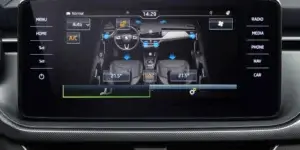Most modern cars now come with air conditioning, even on the most basic models. But some have climate control, which at first glance appears to do much the same job. So, are air conditioning and climate control the same thing? How do you use each system, and which one is best?
In this guide, we’ll answer those questions and many more, to help you understand the difference between air conditioning and climate control.
What is air conditioning?
Often referred to as AC or air con, air conditioning is a system that takes the air in your car and either heats or cools it to a desired temperature. It dehumidifies the air too. It’s a step up from a simple heater, which is fine in the winter to warm up a cold car interior, but less useful in the summer when it’s blazing hot and humid.

How does air conditioning work?
In-car air conditioning uses a heater system and a separate cooling system, which works much in the same way as your fridge. Here’s the science bit: a liquid is turned into a gas inside a device called an evaporator, then a compressor turns the gas back into a liquid. That process cools the area around the liquid and if that area is full of air, then the air turns cool. That cooled (or heated) air is what gets blown into the car’s interior through its air vents.

What are the benefits of air conditioning?
Air conditioning offers several advantages:
- Comfortable Driving: It keeps the car interior at a comfortable temperature, no matter the weather outside.
- Dehumidification: It removes excess moisture from the air, preventing the windows from fogging up.
- Improved Air Quality: By filtering the air, it removes pollen, dust, and other impurities.
For more tips on keeping your car in top condition, check out our car maintenance guide.
What is climate control?
Climate control is a more advanced version of air conditioning. Basic AC units, often found in more affordable cars, let you select whether the AC system is on and you then manually adjust the settings (using buttons or a dial) to make the interior of the car hotter or colder.

How does climate control work?
Climate control systems, however, let you select a target temperature. The system will then use sensors to adjust itself and keep the car at that temperature, without any further input from you. This automation means you can set it and forget it, enjoying a consistently comfortable environment inside your vehicle.
What are the benefits of climate control?
Climate control offers several benefits:
- Set-and-Forget Convenience: Once you set your preferred temperature, the system maintains it without further adjustments.
- Precision: It often allows temperature adjustments in increments as small as 0.5 degrees Celsius.
- Efficiency: It can be more energy-efficient by avoiding overcooling or overheating.
Is climate control better than air conditioning?
What are the key differences?
While both systems aim to control the interior climate, climate control is considered an upgrade over air conditioning. It uses newer, more advanced technology and gives you extra functionality and greater control.
Which one is right for you?
The choice between air conditioning and climate control depends on your needs and preferences. If you appreciate convenience and precise control, climate control might be worth the investment. If you prefer simplicity and cost-effectiveness, basic air conditioning could suffice.
Considering selling your car to upgrade to a model with climate control? Check out our comprehensive guide to the car selling process.

How do I use climate control?
Can climate control be used like basic AC?
You can, if you want, use climate control in much the same way as a more basic AC system, turning the car’s interior temperature up or down as you like and adjusting the fan speed (how hard the air blows through the car’s interior vents) yourself.
How do you set the temperature?
Climate control, however, gives you precise control over the temperature inside your car, usually in increments of 0.5 degrees Celsius. And there’s usually an ‘Auto’ mode that lets you choose the temperature while the climate control automatically adjusts the level of heat/cooling and the strength of the air blowing through the air vents.
For more on maintaining your vehicle’s systems, read our article on car maintenance tips.

What’s two-zone climate control?
What is two-zone climate control?
Many cars have climate control systems that (in theory at least) allow different temperatures in different parts of the car. They’re often referred to as two-zone climate control, or dual-zone climate control, although more expensive cars can have even more zones.
How does it work?
For example, if the driver wants the interior temperature at a chilly 17 degrees C but the passenger would prefer a toasty 21, the climate control system will monitor and adjust each zone accordingly. You can’t stop the air from one side of the car mixing with the other, of course, but this kind of system does allow you to have air of different temperatures coming out of the vents.
Looking for vehicles with advanced features? Check out our best family cars list.

What’s three-zone climate control?
What is three-zone climate control?
In addition to allowing you to set different temperatures for the air flowing to each front seat, three-zone climate control allows you to also select a different temperature for the air going to the back seats.
What about four-zone climate control?
Four-zone climate control goes one step further, splitting each side of the back seat. There are even some seven-seat cars that let you choose a different temperature for the air flowing to the third row of seats.
For a selection of top SUV models with these features, explore our best SUVs guide.

Final Thoughts
Understanding the differences between air conditioning and climate control can help you make an informed decision when purchasing your next vehicle. While air conditioning provides essential comfort and air quality, climate control offers enhanced precision and convenience. Each system has its own merits, and the best choice depends on your personal preferences and budget.
If you’re ready to explore cars with advanced climate control systems, visit our car buying guides for more information. For those interested in the latest electric vehicles that often feature state-of-the-art climate control, check out our electric car buyers guide.


